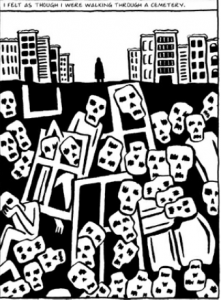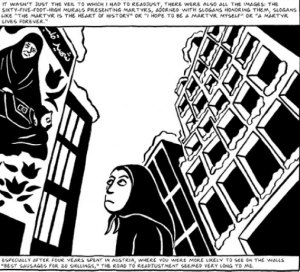By: Nicemode Charles
(Author’s Note; The following is an analytical essay that I wrote for my ENG 110 class; The Craft of Writing. In this essay I analyzed a chapter called THE RETURN in the Complete Persepolis and focused mostly on how Marjane honors the martyrs through her art).

Fig 1. A Panel showing Marjane walking through the street (Satrapi, 250).
“I felt as though I was walking through a cemetery…surrounded by the victims of the war I have fled” (Satrapi, 250). Satrapi use these words in The Complete Persepolis to explain Marjane’s discomfort “and sadness” after walking the streets of Iran in “The Return” (Satrapi, ) This chapter focuses on the effects of the war on people and helps in initiating a turning point for Marjane’s life as she feels guilty for neglecting her country, when she was in Austria while people were suffering and dying in Iran. Marjane’s sickness and her loss of direction make her go back home when her parents invite her. While in Iran, she realizes that her country and her people have suffered a great deal during the war with Iraq. She uses this chance to learn more about Iran and develops a need to help people by speaking out through her art. Her feelings of guilt about denying her Iranian identity while in Austria come back as she realizes that many young people her age sacrificed for the country, but she sacrifices nothing. In this chapter, Satrapi shows Marjane’s coming of age as she learns from her father about the suffering of her fellow citizens and decides that her “Viennese Misadventures” meant nothing in comparison to what her country was going through. In the following pages, I will show how Marjane’s coming of age and experiences help her appreciate martyrs, and women who sacrificed for the war. Satrapi uses picture specific and interdependent panels to bring out Marjane’s emotions about the war and the pain and suffering it brought to her friends, her people, and her country in general. Marjane’s major turning point is seen in the chapter, “The Exam,” where she uses an image of a woman wearing a veil while holding a dead martyr soldier to gain an entrance at the art school (Satrapi, 280). This is the same image she saw on the streets in “The Return,” a few days after coming back to Iran. This moment helps initiate Marjane’s purpose: to use art to honor women and the young people who gave their lives for her country, Iran, and beyond this she uses her art to communicate with the larger world about her complex country and culture.
According to Scott McCloud, in Understanding Comics, in a picture specific panel, an image can vividly convey an author’s ideas (153). In the Fig 1, Satrapi succeeds in incorporating a picture-specific panel to reveal the theme of the pain and grief caused by war and the destruction. In the image, we see Marjane standing in the middle of the city with her back turned away from the reader. Below the city, we see frames of cemeteries and dead people some inside those frames, some not. We also see that some of these dead people have their full body parts and some of them just have faces. This panel evokes complex emotions to the reader. Firstly, it brings fear and sadness as we develop sympathy with the families of these individuals who lost their loved ones during war. The shapes of the dead bodies help us see how people die in horrible ways in war. The city above the cemeteries shows the reader that Iran was once a very powerful country with very beautiful capital city that was very well built before the war destroyed them. The cemeteries below the city show us the effect of the war with Iraq had on people in Iran. Satrapi amplifies this cemetery image to show us how war can bring a lot of grief, loss of hope and permanent changes to people’s lives. This point is emphasized as the cemetery part is large as Satrapi zooms in on it and the city part is small and far away. Satrapi does not show the face of Marjane in the picture, but rather shows us her back facing the cemetery to show her fear of having to look at the devastation the war had brought in Iran. Marjane develops sympathy for the victims of the war and becomes overwhelmed with guilt and shame because her parents helped her escape the war but many other young people did not get that chance. They had to stay to fight and try to survive. After this experience, Marjane decides to use her time in Iran to appreciate the martyrs who sacrificed for the country and people who experienced loss after the war by using her art. It is important to note that Marjane sees her streets as cemeteries because everywhere she walks, she sees images of martyrs and words written in their memories.

Fig 2; Marjane looking at the image of a woman holding a martyr (Satrapi, 204).
“In Interdependent panels, words and pictures go hand in hand to convey an idea that neither could convey alone (Scott 155).” Satrapi uses interdependent panels in “The Return” to show how the post-war period in Iran influenced Marjane to want to do something for her country and for the women in Iran. In Fig 2, we see Marjane staring at a huge image of a woman wearing a veil holding a martyr soldier on her hands with tulips on the side of the image. In the image, the woman looks very sad and Marjane looks very surprised at the impact it brings to her. Satrapi uses the word “martyr” repeatedly to show the effects these images and slogans have on Marjane’s decision to go to art school. The slogans used in this panel show us the effect they have on Marjane. These words make her feel guilty for not loving her country enough to sacrifice her life for it. She is sad because she fled the war and cast away her Iranian identity while people her age suffered. Marjane feels ashamed for not being open minded about her country when it was going through the war. Growing up as a child, Marjane has always wanted a different kind of revolution than the theocratic that actually occurred. When the war happened, she left the country and cast away her culture and identity which cause her to lose herself. The moment Marjane walks through the streets and is aware of images of martyrs is a type of rebirth for her. She uses this experience to get into art school in the following three chapters, culminating in “The Exam” wherein she uses the image above to get an entrance to the art school. Satrapi uses the image of a woman holding a martyred soldier to represent many things. Firstly, it helps us understand the role women played in the war. These women have stronger faith in their government for a chance to a better life by letting their children fight in the war. It also makes women very strong as not everyone will have the courage to let go of her son when she knows that he is going to die. Satrapi uses this image to elevate the position of a woman in her society.. Secondly, the image also shows us that women are more affected by the war as some became widowed and were childless. . Satrapi uses this panel to emphasize the coming of age in Marjane’s life as she learns to see things at different angles and learns to appreciate the role women and martyrs played in her country.
The coming of age is important to Marjane as she learns to appreciate martyrs who die for what they believe in at a point when she herself would fear to fight for what she believed in. In the first few chapters of The Complete Persepolis, we see how Marjane as a child looks down on martyrs as she thinks it was naive to kill yourself to make people believe in what you are fighting for. In “The Return” the older Marjane views martyrs differently: she views them as younger innocent heroes who were manipulated or tricked by the government to fight in the war with the promise that they will go to paradise after that. They were neither trained nor aware that these were lies that the government told them to get more people in the army. Marjane feels sadness and sympathy for the martyrs which influences her to honor them through her art by drawing an image of a woman holding a young martyred soldier. The illustration shows that Satrapi wants to let the readers know about the war from an Iranian’s point of view, not just the media, which eventually influences her to write The Complete Persepolis. We can see that when she says, “This is why writing Persepolis was so important to me. I believe that an entire nation should not be judged by the wrongdoings of a few extremists. I also don’t want those Iranians who lost their lives in prisons defending freedom, who died in the war against Iraq, who suffered under various repressive regimes, or who were forced to leave their families and flee their homeland to be forgotten (Satrapi 1).” This shows the rebellious side of Marjane as she tries to address the government who lied and forced many young people to fight during the war with empty promises. She also tries to correct her past mistakes by doing the right thing: to stand up and appreciate the innocent people who lost their lives even when the government was manipulative and did not genuinely care for the lives of people.
Works Cited
Satrapi, Marjane. The Complete Persepolis. Pantheon, 2004.
Scott, McCloud. Understanding Comics, Kitchen Sink Press, 1993.